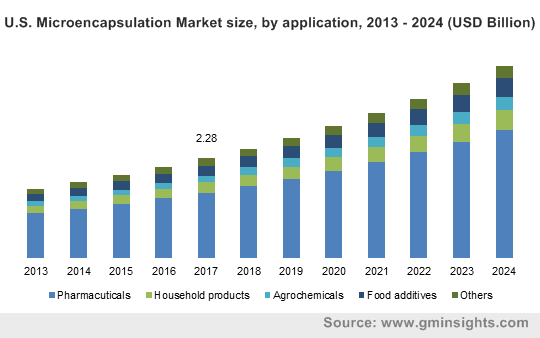APAC Microencapsulation Market to amass remarkable gains by 2024, extensive R&D activities to outline the industry landscape
Publisher : Fractovia | Latest Update: 2019-03-18 | Published Date : 2017-12-11Request Sample
Frutarom’s recent acquisition of AB-Fortis can be placed as an apt instance depicting signs of expansion of microencapsulation market. A profound vertical of polymer and advanced materials space, microencapsulation market, has been witnessing a remarkable momentum recent times, quite evident from the numerous efforts undertaken by renowned giants to unlock its potential in as many applications as possible.
U.S. Microencapsulation Market size, by application, 2013 - 2024 (USD Billion)

The incorporation of AB-Biotics’ two-layer microencapsulation technology, christened as AB-Fortis by Frutarom is a testament to the aforementioned. Allegedly, with this takeover, the Israel based flavor giant is planning to incorporate microencapsulation technology in food processing, in a bid to increase the iron absorbability in tissues without any side effects and compromise on taste. While the acquisition is mainly on the heels of strengthening Frutarom’s market position in specialty chemical space, it is indisputable that microencapsulation industry dynamics would also witness a significant impetus post this agreement.
The pharmaceutical domain, unquestionably, is one of the pronounced end-use domains of microencapsulation industry. Of late, the microencapsulation technology has been gaining a renewed attention in the field of tissue engineering, drug development, as well as in oral delivery systems. In fact, estimates depict that a large number of microencapsulated products have been already commercialized for the quick delivery of pharmaceutics. Driven by the fact that microencapsulated molecules bring forth a host of benefits, controlled drug delivery being at the pinnacle, overall microencapsulation industry from pharma applications alone will garner a hefty proportion of the overall revenue by 2024.
Speaking of the geographical penetration, the growth prospect of North America microencapsulation market is forecast to be positively high, primarily driven by the significant contribution of U.S. in biotech and pharmaceutical sectors. Estimates depict that U.S. alone accounted for a major percentage of the overall pharmaceutical market share in 2016, with an extensive worth. In another report it has been claimed that United States biopharmaceutical market is presently the largest and accounts for almost one-third of the overall share. In conjecture, the country is reported to invest maximum in biopharmaceutical research and development. These statistics are evidence enough to state that with U.S. at the growth front, North America would prove to be one of the most opportunistic growth avenues for microencapsulation industry.
The tremendous expansion and technological advancements in the healthcare space across Europe & North America, as claimed by experts, is primarily responsible for the wide-scale incorporation of this technology in the field of pharmaceutics. In tandem, growing consumer acceptance of functional food additives and household products are also widening the application scope of microencapsulation market in these regions.
Another regional ground that is forecast to gain traction in microencapsulation industry over 2017-2024 is Asia Pacific. As a matter of fact, credited to the increasing awareness pertaining to health, rising disposable incomes, and the shifting dietary & retail landscapes, APAC microencapsulation market valuation is touted to hit USD 2 billion by 2024.
It is imperative for microencapsulation industry giants to keep in mind that extensive research and development activities are much required to choose the appropriate production technology and core materials for microcapsules. In this regard, some of the cost intensive production processes such as field trials, pilot scale testing, are somewhat acting as a deterrent in the business growth. Perhaps marred by the fact that these material development processes are expensive, the final pricing trends often tend to end up a little higher than its conventional counterparts.
Experts deemed this to be one of the most deterring factors hindering the market penetration in some of the low budget application domains. However, renowned biggies partaking in microencapsulation market have been focusing on R&D activities to bring cost-effective alternative solutions. Given the extensive deployment of microencapsulation technology across myriad end-use domains, the overall microencapsulation industry space is forecast to garner a revenue of USD 14 billion by 2024.